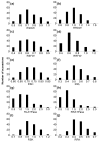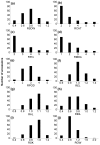Response of Tibetan Wild Barley Genotypes to Drought Stress and Identification of Quantitative Trait Loci by Genome-Wide Association Analysis
- PMID: 30759829
- PMCID: PMC6387302
- DOI: 10.3390/ijms20030791
Response of Tibetan Wild Barley Genotypes to Drought Stress and Identification of Quantitative Trait Loci by Genome-Wide Association Analysis
Abstract
Tibetan wild barley has been identified to show large genetic variation and stress tolerance. A genome-wide association (GWA) analysis was performed to detect quantitative trait loci (QTLs) for drought tolerance using 777 Diversity Array Technology (DArT) markers and morphological and physiological traits of 166 Tibetan wild barley accessions in both hydroponic and pot experiments. Large genotypic variation for these traits was found; and population structure and kinship analysis identified three subpopulations among these barley genotypes. The average LD (linkage disequilibrium) decay distance was 5.16 cM, with the minimum on 6H (0.03 cM) and the maximum on 4H (23.48 cM). A total of 91 DArT markers were identified to be associated with drought tolerance-related traits, with 33, 26, 16, 1, 3, and 12 associations for morphological traits, H⁺K⁺-ATPase activity, antioxidant enzyme activities, malondialdehyde (MDA) content, soluble protein content, and potassium concentration, respectively. Furthermore, 7 and 24 putative candidate genes were identified based on the reference Meta-QTL map and by searching the Barleymap. The present study implicated that Tibetan annual wild barley from Qinghai⁻Tibet Plateau is rich in genetic variation for drought stress. The QTLs detected by genome-wide association analysis could be used in marker-assisting breeding for drought-tolerant barley genotypes and provide useful information for discovery and functional analysis of key genes in the future.
Keywords: Diversity Array Technology (DArT) markers; Hordeum vulgare L. ssp. vulgare; drought stress; genome-wide association (GWA); quantitative trait loci (QTL) mapping.
Conflict of interest statement
The authors declare no conflict of interest.
Figures




References
-
- Cattivelli L., Rizza F., Badeck F.W., Mazzucotelli E., Mastrangelo A.M., Francia E., Mare C., Tondelli A., Stanca A.M. Drought tolerance improvement in crop plants: An integrated view from breeding to genomics. Field Crops Res. 2008;105:1–14. doi: 10.1016/j.fcr.2007.07.004. - DOI
-
- Zhang M., Jin Z.Q., Zhao J., Zhang G.P., Wu F.B. Physiological and biochemical responses to drought stress in cultivated and Tibetan wild barley. Plant Growth Regul. 2015;75:567–574. doi: 10.1007/s10725-014-0022-x. - DOI
MeSH terms
Substances
Grants and funding
LinkOut - more resources
Full Text Sources
Research Materials

